2016 NISSAN MURANO light
[x] Cancel search: lightPage 10 of 465
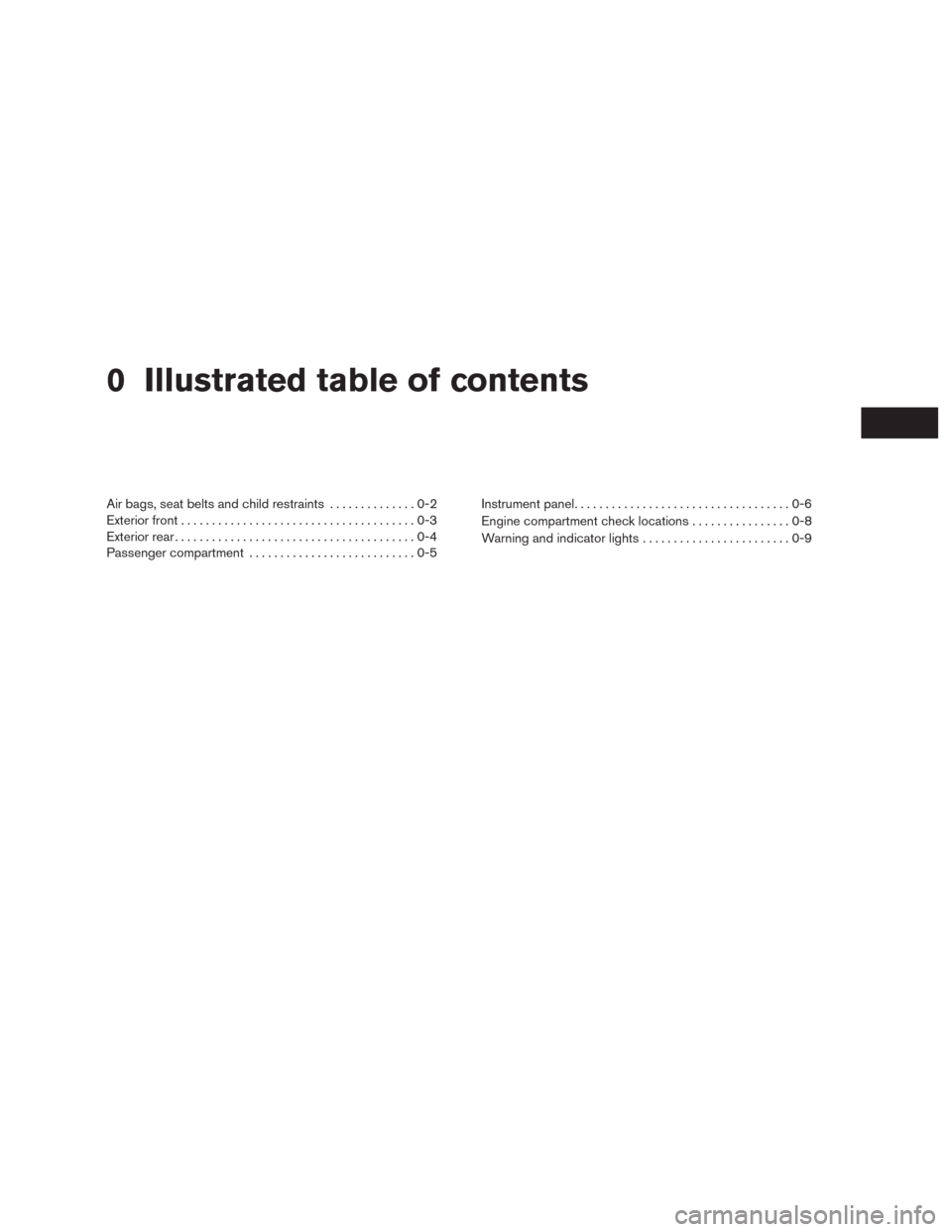
0 Illustrated table of contents
Air bags, seat belts and child restraints..............0-2
Exterior front......................................0-3
Exterior rear.......................................0-4
Passenger compartment...........................0-5Instrument panel...................................0-6
Engine compartment check locations . ...............0-8
Warning and indicator lights........................0-9
Page 12 of 465
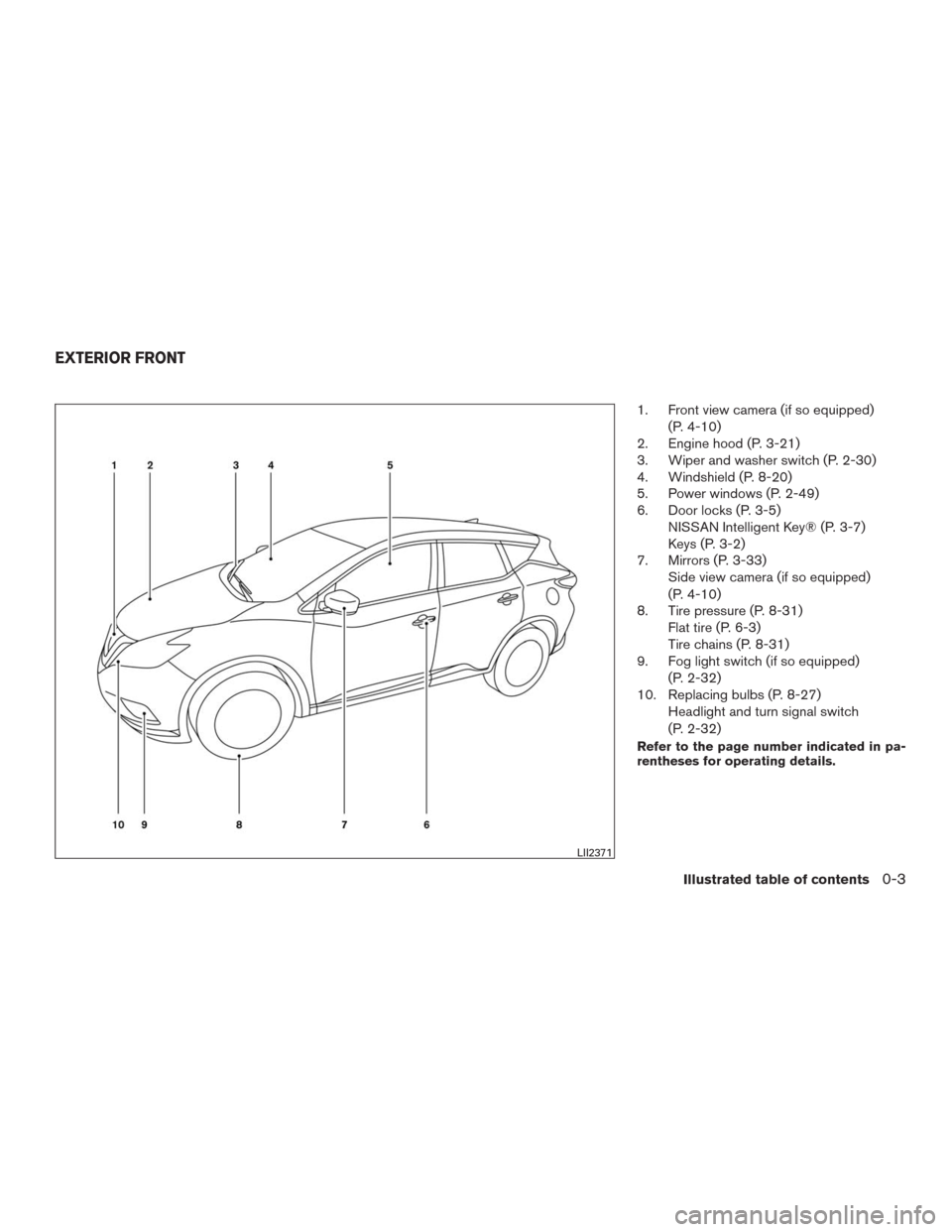
1. Front view camera (if so equipped)
(P. 4-10)
2. Engine hood (P. 3-21)
3. Wiper and washer switch (P. 2-30)
4. Windshield (P. 8-20)
5. Power windows (P. 2-49)
6. Door locks (P. 3-5)
NISSAN Intelligent Key® (P. 3-7)
Keys (P. 3-2)
7. Mirrors (P. 3-33)
Side view camera (if so equipped)
(P. 4-10)
8. Tire pressure (P. 8-31)
Flat tire (P. 6-3)
Tire chains (P. 8-31)
9. Fog light switch (if so equipped)
(P. 2-32)
10. Replacing bulbs (P. 8-27)
Headlight and turn signal switch
(P. 2-32)
Refer to the page number indicated in pa-
rentheses for operating details.
LII2371
EXTERIOR FRONT
Illustrated table of contents0-3
Page 14 of 465
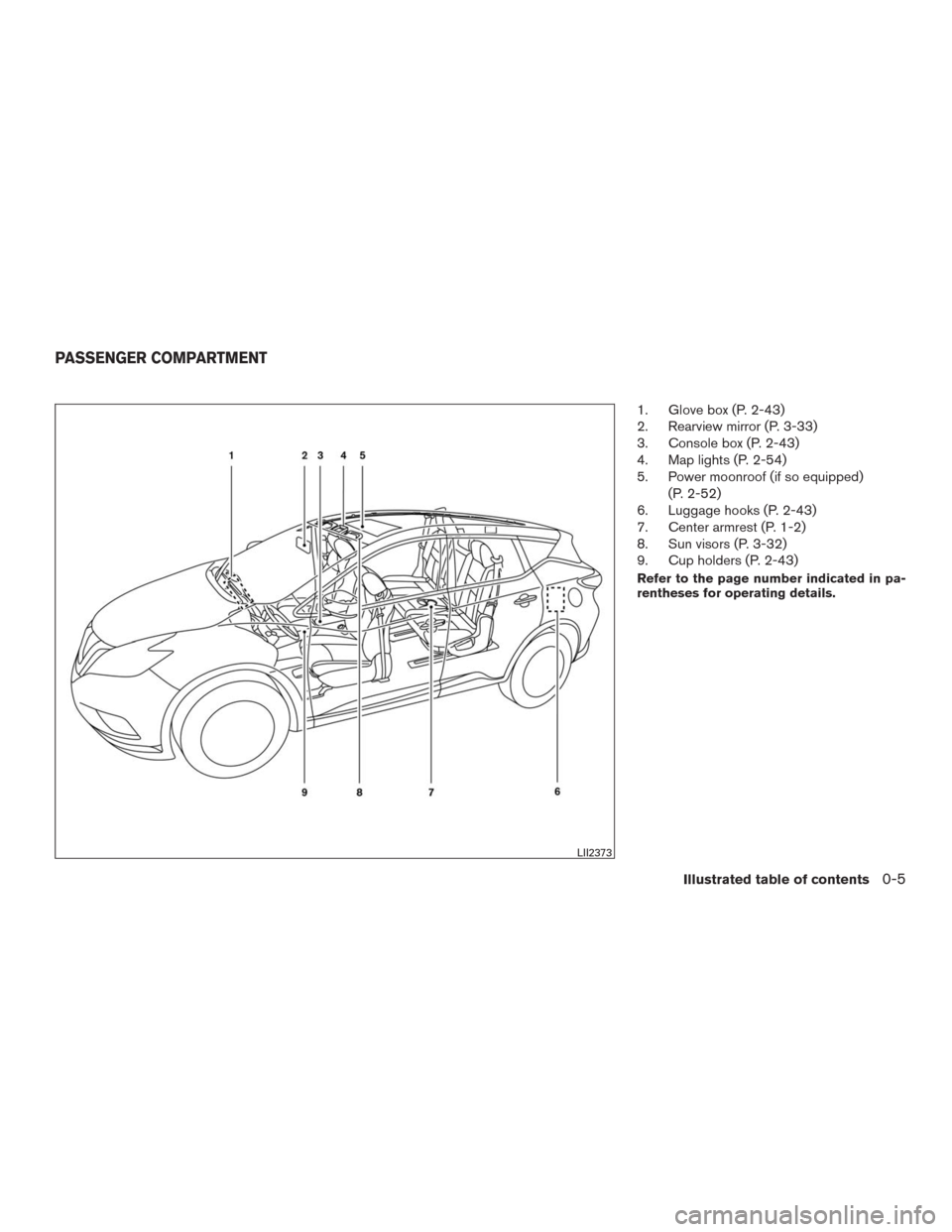
1. Glove box (P. 2-43)
2. Rearview mirror (P. 3-33)
3. Console box (P. 2-43)
4. Map lights (P. 2-54)
5. Power moonroof (if so equipped)
(P. 2-52)
6. Luggage hooks (P. 2-43)
7. Center armrest (P. 1-2)
8. Sun visors (P. 3-32)
9. Cup holders (P. 2-43)
Refer to the page number indicated in pa-
rentheses for operating details.
LII2373
PASSENGER COMPARTMENT
Illustrated table of contents0-5
Page 15 of 465
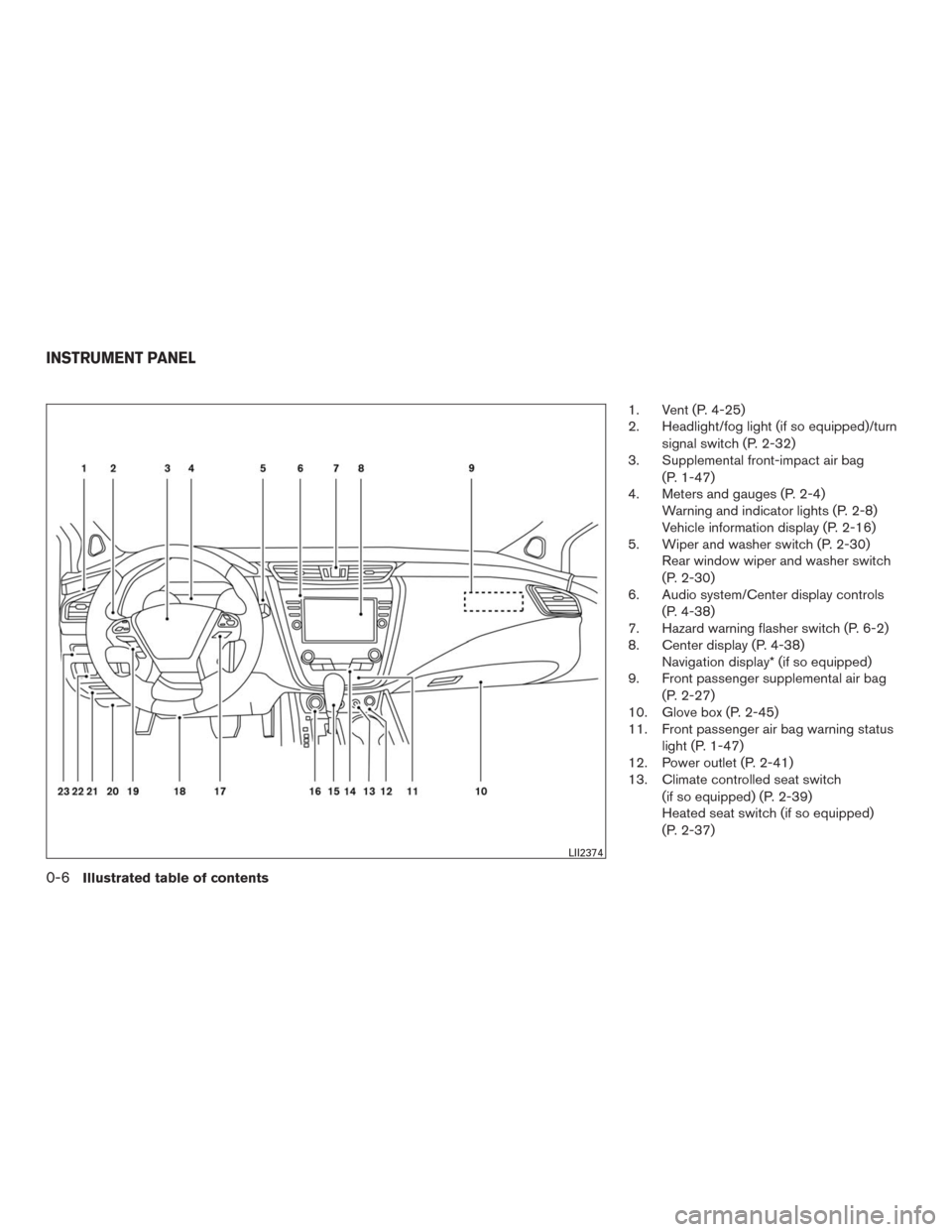
1. Vent (P. 4-25)
2. Headlight/fog light (if so equipped)/turn
signal switch (P. 2-32)
3. Supplemental front-impact air bag
(P. 1-47)
4. Meters and gauges (P. 2-4)
Warning and indicator lights (P. 2-8)
Vehicle information display (P. 2-16)
5. Wiper and washer switch (P. 2-30)
Rear window wiper and washer switch
(P. 2-30)
6. Audio system/Center display controls
(P. 4-38)
7. Hazard warning flasher switch (P. 6-2)
8. Center display (P. 4-38)
Navigation display* (if so equipped)
9. Front passenger supplemental air bag
(P. 2-27)
10. Glove box (P. 2-45)
11. Front passenger air bag warning status
light (P. 1-47)
12. Power outlet (P. 2-41)
13. Climate controlled seat switch
(if so equipped) (P. 2-39)
Heated seat switch (if so equipped)
(P. 2-37)
LII2374
INSTRUMENT PANEL
0-6Illustrated table of contents
Page 18 of 465
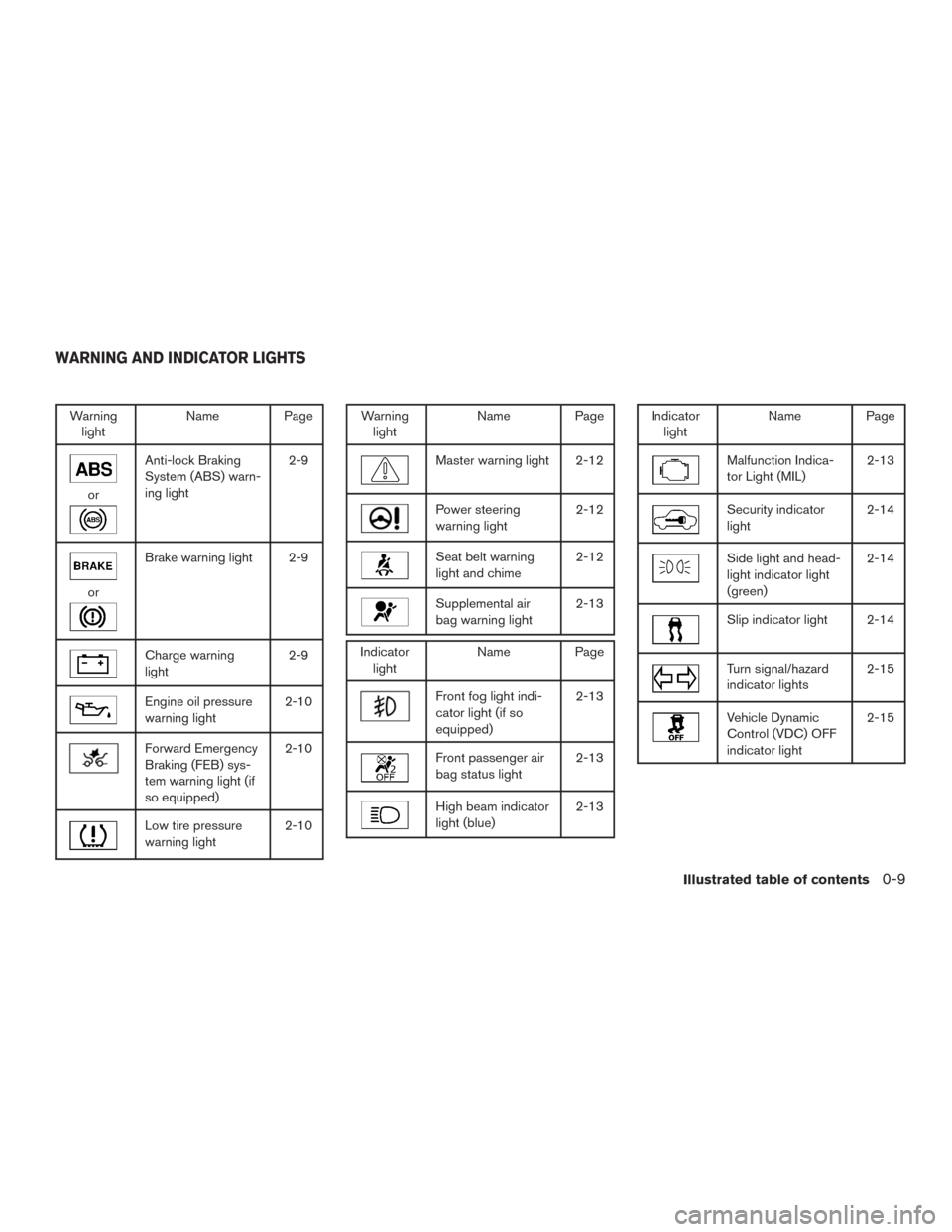
Warning
lightName Page
or
Anti-lock Braking
System (ABS) warn-
ing light2-9
or
Brake warning light 2-9
Charge warning
light2-9
Engine oil pressure
warning light2-10
Forward Emergency
Braking (FEB) sys-
tem warning light (if
so equipped)2-10
Low tire pressure
warning light2-10
Warning
lightName Page
Master warning light 2-12
Power steering
warning light2-12
Seat belt warning
light and chime2-12
Supplemental air
bag warning light2-13
Indicator
lightName Page
Front fog light indi-
cator light (if so
equipped)2-13
Front passenger air
bag status light2-13
High beam indicator
light (blue)2-13
Indicator
lightName Page
Malfunction Indica-
tor Light (MIL)2-13
Security indicator
light2-14
Side light and head-
light indicator light
(green)2-14
Slip indicator light 2-14
Turn signal/hazard
indicator lights2-15
Vehicle Dynamic
Control (VDC) OFF
indicator light2-15
WARNING AND INDICATOR LIGHTS
Illustrated table of contents0-9
Page 20 of 465
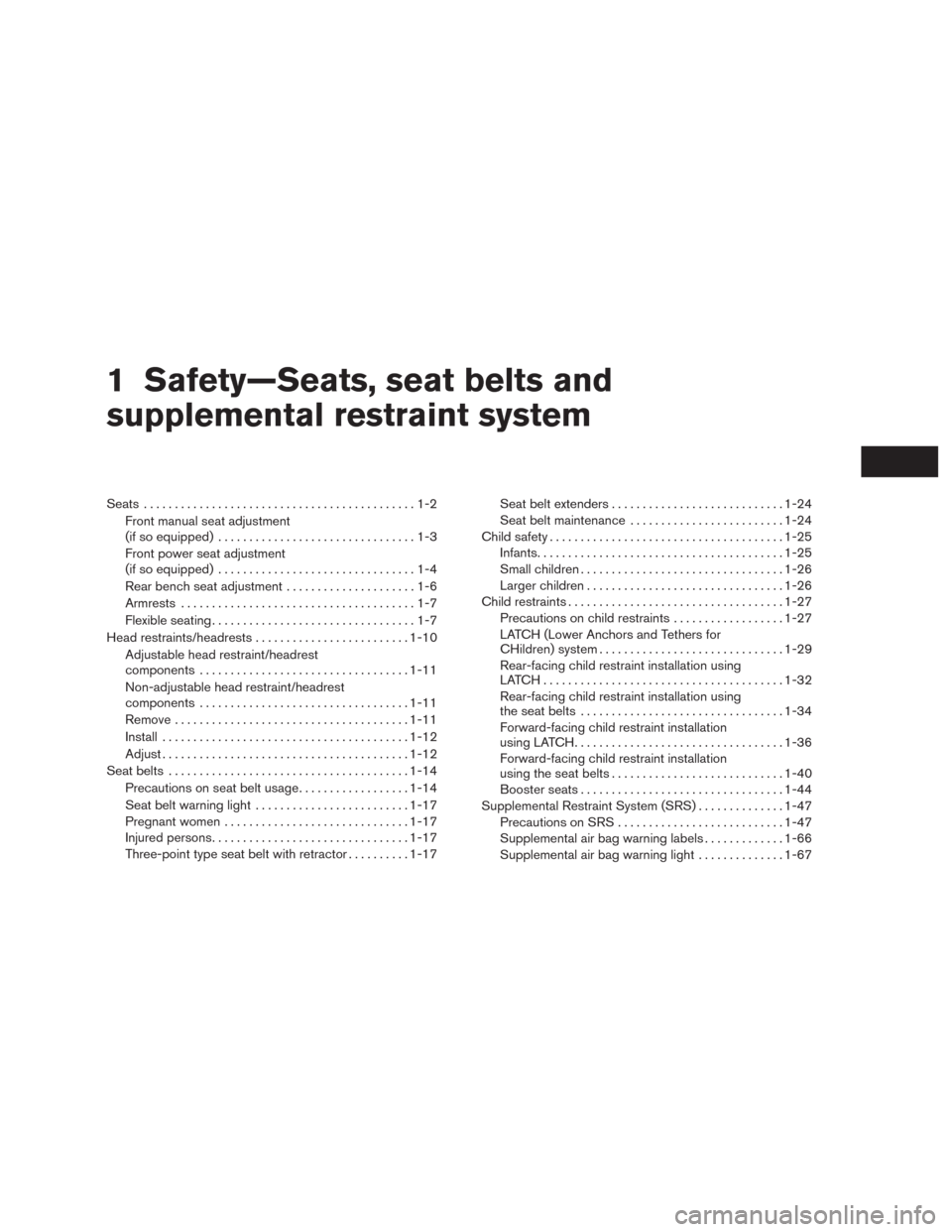
1 Safety—Seats, seat belts and
supplemental restraint system
Seats............................................1-2
Front manual seat adjustment
(if so equipped)................................1-3
Front power seat adjustment
(if so equipped)................................1-4
Rear bench seat adjustment.....................1-6
Armrests......................................1-7
Flexible seating.................................1-7
Head restraints/headrests.........................1-10
Adjustable head restraint/headrest
components..................................1-11
Non-adjustable head restraint/headrest
components..................................1-11
Remove......................................1-11
Install........................................1-12
Adjust........................................1-12
Seat belts.......................................1-14
Precautions on seat belt usage..................1-14
Seat belt warning light.........................1-17
Pregnant women..............................1-17
Injured persons................................1-17
Three-point type seat belt with retractor..........1-17Seat belt extenders............................1-24
Seat belt maintenance.........................1-24
Child safety......................................1-25
Infants........................................1-25
Small children.................................1-26
Larger children................................1-26
Child restraints...................................1-27
Precautions on child restraints..................1-27
LATCH (Lower Anchors and Tethers for
CHildren) system..............................1-29
Rear-facing child restraint installation using
LATCH.......................................1-32
Rear-facing child restraint installation using
the seat belts.................................1-34
Forward-facing child restraint installation
using LATCH..................................1-36
Forward-facing child restraint installation
using the seat belts............................1-40
Booster seats.................................1-44
Supplemental Restraint System (SRS)..............1-47
Precautions on SRS...........................1-47
Supplemental air bag warning labels.............1-66
Supplemental air bag warning light..............1-67
Page 35 of 465
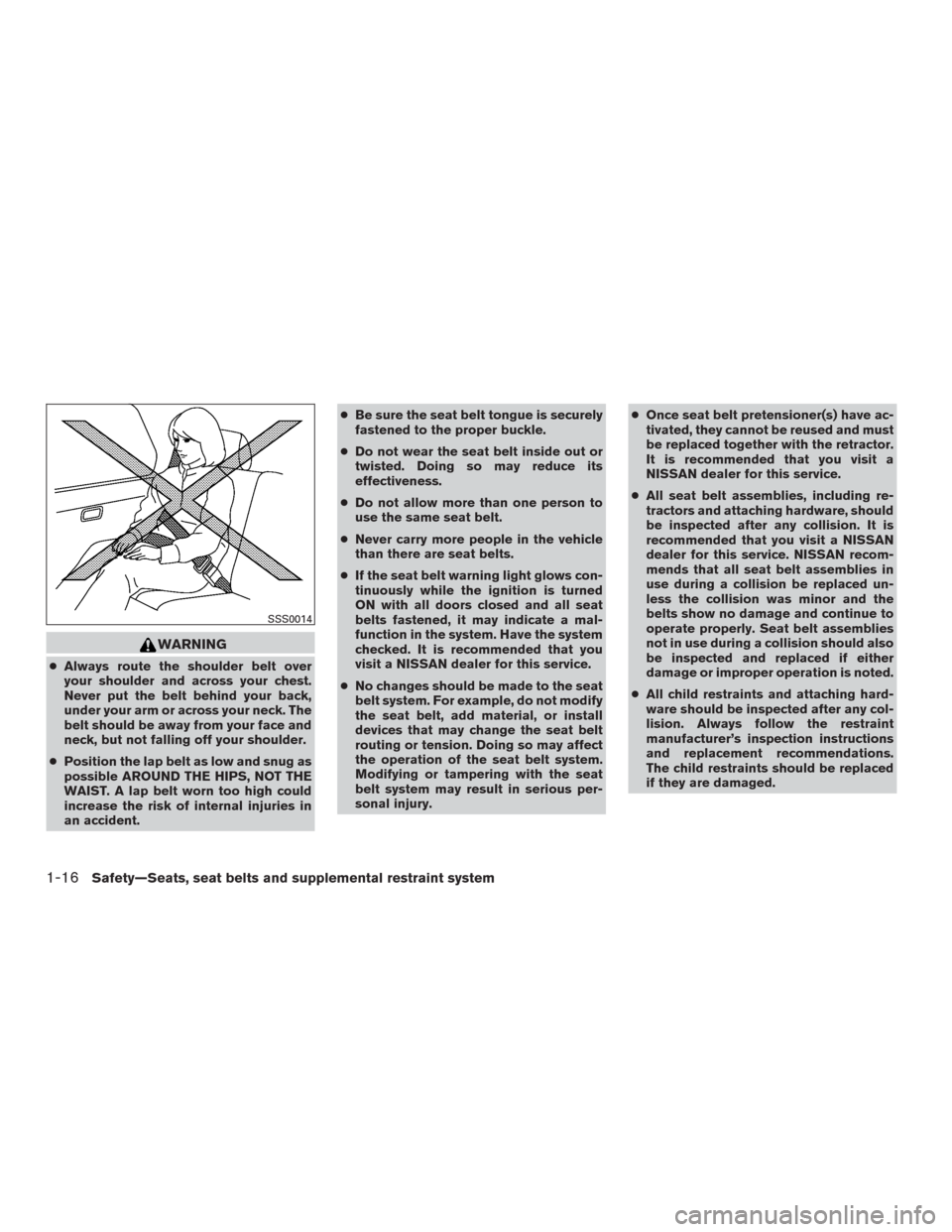
WARNING
●Always route the shoulder belt over
your shoulder and across your chest.
Never put the belt behind your back,
under your arm or across your neck. The
belt should be away from your face and
neck, but not falling off your shoulder.
●Position the lap belt as low and snug as
possible AROUND THE HIPS, NOT THE
WAIST. A lap belt worn too high could
increase the risk of internal injuries in
an accident.●Be sure the seat belt tongue is securely
fastened to the proper buckle.
●Do not wear the seat belt inside out or
twisted. Doing so may reduce its
effectiveness.
●Do not allow more than one person to
use the same seat belt.
●Never carry more people in the vehicle
than there are seat belts.
●If the seat belt warning light glows con-
tinuously while the ignition is turned
ON with all doors closed and all seat
belts fastened, it may indicate a mal-
function in the system. Have the system
checked. It is recommended that you
visit a NISSAN dealer for this service.
●No changes should be made to the seat
belt system. For example, do not modify
the seat belt, add material, or install
devices that may change the seat belt
routing or tension. Doing so may affect
the operation of the seat belt system.
Modifying or tampering with the seat
belt system may result in serious per-
sonal injury.●Once seat belt pretensioner(s) have ac-
tivated, they cannot be reused and must
be replaced together with the retractor.
It is recommended that you visit a
NISSAN dealer for this service.
●All seat belt assemblies, including re-
tractors and attaching hardware, should
be inspected after any collision. It is
recommended that you visit a NISSAN
dealer for this service. NISSAN recom-
mends that all seat belt assemblies in
use during a collision be replaced un-
less the collision was minor and the
belts show no damage and continue to
operate properly. Seat belt assemblies
not in use during a collision should also
be inspected and replaced if either
damage or improper operation is noted.
●All child restraints and attaching hard-
ware should be inspected after any col-
lision. Always follow the restraint
manufacturer’s inspection instructions
and replacement recommendations.
The child restraints should be replaced
if they are damaged.
SSS0014
1-16Safety—Seats, seat belts and supplemental restraint system
Page 36 of 465
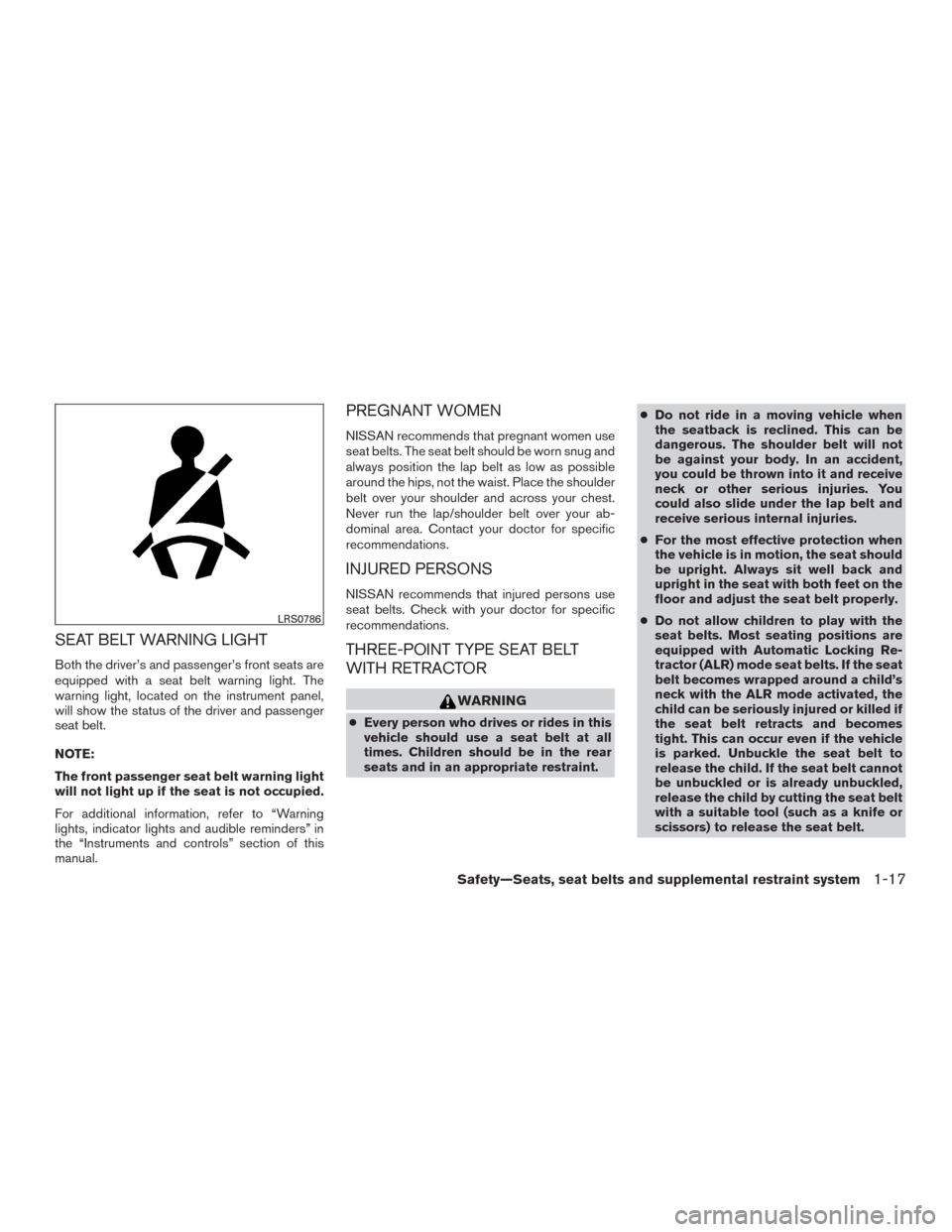
SEAT BELT WARNING LIGHT
Both the driver’s and passenger’s front seats are
equipped with a seat belt warning light. The
warning light, located on the instrument panel,
will show the status of the driver and passenger
seat belt.
NOTE:
The front passenger seat belt warning light
will not light up if the seat is not occupied.
For additional information, refer to “Warning
lights, indicator lights and audible reminders” in
the “Instruments and controls” section of this
manual.
PREGNANT WOMEN
NISSAN recommends that pregnant women use
seat belts. The seat belt should be worn snug and
always position the lap belt as low as possible
around the hips, not the waist. Place the shoulder
belt over your shoulder and across your chest.
Never run the lap/shoulder belt over your ab-
dominal area. Contact your doctor for specific
recommendations.
INJURED PERSONS
NISSAN recommends that injured persons use
seat belts. Check with your doctor for specific
recommendations.
THREE-POINT TYPE SEAT BELT
WITH RETRACTOR
WARNING
●Every person who drives or rides in this
vehicle should use a seat belt at all
times. Children should be in the rear
seats and in an appropriate restraint.●Do not ride in a moving vehicle when
the seatback is reclined. This can be
dangerous. The shoulder belt will not
be against your body. In an accident,
you could be thrown into it and receive
neck or other serious injuries. You
could also slide under the lap belt and
receive serious internal injuries.
●For the most effective protection when
the vehicle is in motion, the seat should
be upright. Always sit well back and
upright in the seat with both feet on the
floor and adjust the seat belt properly.
●Do not allow children to play with the
seat belts. Most seating positions are
equipped with Automatic Locking Re-
tractor (ALR) mode seat belts. If the seat
belt becomes wrapped around a child’s
neck with the ALR mode activated, the
child can be seriously injured or killed if
the seat belt retracts and becomes
tight. This can occur even if the vehicle
is parked. Unbuckle the seat belt to
release the child. If the seat belt cannot
be unbuckled or is already unbuckled,
release the child by cutting the seat belt
with a suitable tool (such as a knife or
scissors) to release the seat belt.
LRS0786
Safety—Seats, seat belts and supplemental restraint system1-17